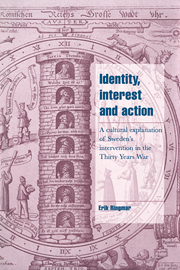 Identity, Interest and Action
Identity, Interest and Action Book contents
- Frontmatter
- Contents
- List of illustrations
- Acknowledgements
- Introduction: the beginning of the story
- Part I A narrative theory of action
- Part II Why did Sweden go to war in 1630?
- 4 Historical and cultural preliminaries
- 5 Fighting for a national interest
- 6 Fighting for a national identity
- Conclusion: the end of the story?
- Notes
- Bibliography
- Index
5 - Fighting for a national interest
Published online by Cambridge University Press: 21 October 2009
- Frontmatter
- Contents
- List of illustrations
- Acknowledgements
- Introduction: the beginning of the story
- Part I A narrative theory of action
- Part II Why did Sweden go to war in 1630?
- 4 Historical and cultural preliminaries
- 5 Fighting for a national interest
- 6 Fighting for a national identity
- Conclusion: the end of the story?
- Notes
- Bibliography
- Index
Summary
Let us now turn directly to a study of the historical source material. In this chapter we will explain the decision to go to war as an attempt on the part of the Swedish leaders to act in a rational, utility-driven, manner; we will assume that Sweden went to war in defence of its interests and analyse how those interests were defined. To this end we will rely on statements made by king Gustav Adolf and other Swedish decision-makers throughout the course of the 1620s. Over and over again the reasons for and against an intervention into the ‘German war’ were discussed: ‘What are the Austrians up to?’; ‘How should we best respond?’ ‘If we go to war, where and how should we fight it?’ ‘Is a war really in accordance with the stipulations of international law and with the wishes of God?’
The primary source material is of three different kinds: protocols of the meetings of the Council of the Realm where the king's official group of advisers met to discuss the action; resolutions taken by the Swedish parliament, the Diet, and the speeches which the king addressed to its four estates; and letters exchanged between the king and his confidants – notably the Chancellor, Axel Oxenstierna – as well as the Danish king Kristian IV and other foreign, chiefly German, princes. In order to map this material we will arrange it along a time dimension and what we called in part I a ‘communicative dimension’.
- Type
- Chapter
- Information
- Identity, Interest and ActionA Cultural Explanation of Sweden's Intervention in the Thirty Years War, pp. 110 - 144Publisher: Cambridge University PressPrint publication year: 1996
